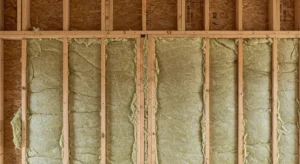Nothing ruins a peaceful morning like spotting water droplets sliding down your walls or catching that faint musty smell hinting at mold growth. Wall condensation isn’t just a cosmetic nuisance—it can weaken paint, damage furniture, and quietly sabotage home interiors. For commercial spaces, damp walls can affect both appearance and long-term structural integrity.
The frustrating part? Many people heat the room, open windows, or buy fancy dehumidifiers, only to find the problem stubbornly sticking around. Professional wall insulation isn’t just a ‘nice-to-have’—it reduces condensation, stabilizes surface temperatures, and keeps spaces comfortable and dry without endless interventions.
How Condensation Forms on Walls
Condensation happens when warm, humid air meets a cooler wall surface. As the air cools, it can’t hold as much moisture, and water droplets start forming. High humidity in kitchens, bathrooms, or laundry areas accelerates this process, while uninsulated walls feel particularly cold and attract more condensation.
Why Some Walls Condense More
Walls with minimal or no insulation are prone to colder surface temperatures. Moist air clings to these cold surfaces, forming condensation that can drip or sit as a thin, damaging film. Poor ventilation compounds the issue, leaving dampness trapped in corners or behind furniture.
Wall Materials and Temperature Retention
Materials like brick and concrete cool quickly, making them high-risk surfaces for condensation. Wood, insulated panels, or walls with thermal buffering retain warmth better, reducing droplet formation and lowering the risk of mold growth.
Fun fact: Even if indoor air feels “dry,” everyday activities like showering or cooking can push moisture levels high enough to trigger condensation on uninsulated walls.
How Wall Insulation Helps
Insulation works by creating a thermal barrier between indoor air and the colder wall surface. By keeping the wall warmer, it narrows the temperature gap that causes condensation.
Types of Insulation
Foam-Based Insulation
Expands to fill gaps, eliminating cold spots where condensation can accumulate. It seals cracks that act as moisture traps.
Fiberglass Batts
Slows heat transfer and stabilizes wall temperature. Flexible enough to fit between studs without losing insulating efficiency.
Spray Foam
Adds R-value while sealing small cracks. Prevents both heat loss and air leakage, lowering condensation risk.
Internal vs. External Insulation
Internal insulation warms the inner wall surface, directly reducing condensation. External insulation stabilizes the wall’s entire temperature profile, lowering overall moisture accumulation and enhancing structural protection.
Fun fact: Homes with properly installed insulation can reduce condensation on interior walls by up to 50%, especially in damp-prone rooms like bathrooms or basements.
Comparing Insulated and Non-Insulated Walls
Insulation doesn’t just make a house cozier; it transforms how moisture interacts with wall surfaces. Here’s a quick comparison:
| Feature | Insulated Wall | Non-Insulated Wall |
|---|---|---|
| Surface temperature | Stable, closer to room temp | Fluctuates, often colder |
| Condensation likelihood | Low | High |
| Mold growth potential | Reduced | Increased |
| Energy efficiency | Improved | Poor |
| Long-term wall damage | Minimal | Likely |
Practical Implications
Insulated walls improve energy efficiency, protect interiors, and reduce long-term repair costs. For commercial properties, this translates to healthier environments and fewer complaints about damp interiors.
Common Mistakes to Avoid
Even with insulation, condensation can persist if other factors aren’t addressed.
Poor Ventilation
Blocked airflow traps moisture. Fans, vents, or strategically placed air circulators help remove humidity, complementing insulation benefits.
Insulation Gaps
Missed gaps or compressed material creates cold bridges. Even a small uninsulated area can attract noticeable condensation.
Persistent Moisture Sources
Drying clothes indoors, over-humidifying, or repeated cooking without proper ventilation can overwhelm insulation, leaving walls damp.
Fun fact: Cold bridges aren’t just theoretical—they’re responsible for noticeable mold streaks near windows, corners, and ceilings in many homes.
Conclusion
Wall insulation directly impacts condensation by keeping wall surfaces closer to room temperature. By reducing the temperature differential between air and wall, insulation prevents water from forming droplets that can damage paint, furniture, and the wall structure itself. Properly installed insulation paired with adequate ventilation ensures long-term protection from moisture, whether in residential or commercial properties.
Beyond condensation control, insulation improves energy efficiency, enhances comfort, and preserves interior aesthetics. Selecting the right type and placement of insulation prevents cold spots, cuts energy waste, and maintains a healthier indoor environment. Combined with moisture management strategies, wall insulation is one of the most effective defenses against damp walls.
Learn more about at: https://www.stellrr.com/?utm_source=backlink
FAQs
How does insulation prevent mold growth?
Insulation reduces condensation by keeping wall surfaces warmer, which lowers the moisture that mold needs to thrive. Maintaining dry walls decreases the likelihood of spores forming and spreading indoors.
Can insulation fix existing condensation problems?
Insulation helps, but it works best alongside proper ventilation and moisture source control. Addressing leaks, high humidity, and air circulation ensures long-term results.
Is internal or external insulation better for condensation control?
Internal insulation warms the interior surface directly, reducing condensation inside the room. External insulation maintains uniform wall temperature, preventing moisture buildup throughout the structure.
Do all insulation types perform equally against condensation?
No. Dense materials like spray foam or foam boards outperform loose-fill insulation because they seal gaps and retain heat more effectively, reducing surface condensation points.
Will insulation affect indoor humidity levels?
Insulation stabilizes wall temperatures but doesn’t reduce humidity directly. Managing humidity through ventilation and moisture control is still necessary for a dry, comfortable environment.
Reviewer: Sophia White has 8 years of experience in spray foam insulation. She reviewed this post and gave clear guidance on aligning business messaging with what customers actually care about.

